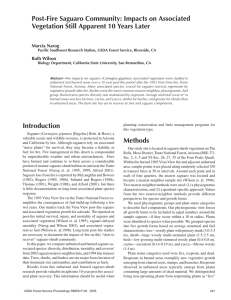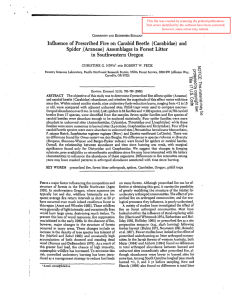C SOUTHWEST Forest and
advertisement
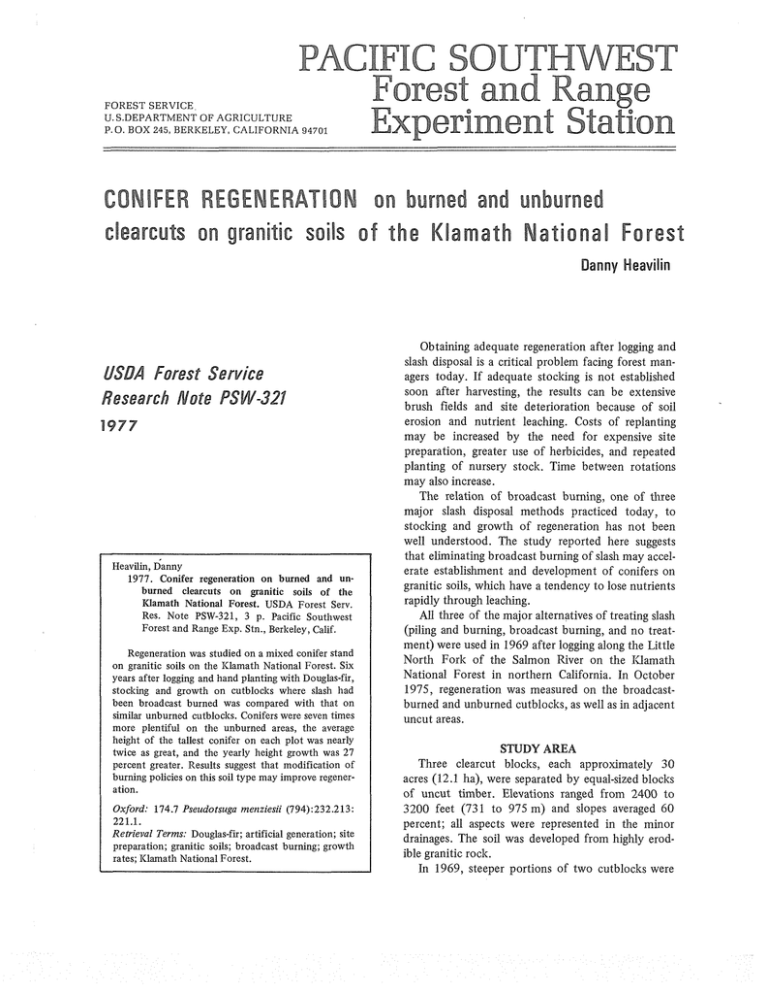
C SOUTHWEST FOREST SERVICE U. S.DEPARTMENT OF AGRICULTURE P.O. BOX 245, BERKELEY, CALIFORNIA 94701 Forest and Range CONIFER REGEN ERATION on burned and unburned clearcuts on granitic soi s of the Klamath Nationa Danny Neavilin USDA Foresf Servke Research Note PSW-321 1997 I regeneration o n burned and unarcuts on granitic soils of the Res. Note PSW-321, 3 p. Pacific Southwest Forest and Range Exp. Stn., Berkeley, Calif. Regeneration was studied on a mixed conifer stand on granitic soils on the Klamath National Forest. Six years after logging and hand planting with Douglas-fir, stocking and growth on cutblocks where slash had been broadcast burned was compared with that on similar unburned cutblocks. Conifers were seven times more plentiful on the unburned areas, the average height of the tallest conifer on each plot was nearly twice as great, and the yearly height growth was 27 percent greater. Results suggest that modification of burning policies on this soil type may improve regener: 174.7 Pseudotsuga rnenziesii (794):232.213: Obtaining adequate regeneration after logging and slash disposal is a critical problem facing forest managers today. If adequate stocking is not established soon after harvesting, the results can be extensive brush fields and site deterioration because of soil erosion and nutrient leaching. Costs of replanting may be increased by the need for expensive site preparation, greater use of herbicides, and repeated planting of nursery stock. Time between rotations may also increase. The relation of broadcast burning, one of three major slash disposal methods practiced today, to stocking and growth of regeneration has not been well understood. The study reported here suggests that eliminating broadcast burning of slash may accelerate establishment and development of conifers on granitic soils, which have a tendency to lose nutrients rapidly through leaching. All three of the major alternatives of treating slash (piling and burning, broadcast burning, and no treatment) were used in 1969 after logging along the Little North Fork of the Salmon River on the Iaamath National Forest in northern California. In October 1975, regeneration was measured on the broadcastburned and unburned cutblocks, as well as in adjacent uncut areas. STUDY AREA Three clearcut blocks, each approximately 30 acres (12.1 ha), were separated by equal-sized blocks of uncut timber. Elevations ranged from 2400 to 3200 feet (73 1 to 975 m) and slopes averaged 60 percent; all aspects were represented in the minor drainages. The soil was developed from highly erodible granitic rock. In 1969, steeper portions of two cutblocks were broadcast-burned; the gentler slopes were mechanically piled and burned. The third cutblockc was left unburned. All areas were then hand planted with Douglas-fir (Pseudotsuga menziesii) bare root planting stock. Deer brush (Ceanothus integerrimus), with an average height of 6 feet (1.8 m), is the predominant brush species on all cutblocks. Also present are scattered clones of Pacific madrone (Arbutus menziesii), bigleaf maple (Acer macrophyllum), and hazel (Cotylus cornuta californica). These clones range up to 16 feet (4.9 m) in height but do not appear to discourage conifer reproduction at this time. The uncut stand in the immediate area has three distinct levels. Douglas-fir makes up 65 percent of the overstory. The remaining 35 percent is ponderosa pine (Pinus ponderosa), sugar pine (Pinus lambertiana), and white fir (Abies concolor). The major species at the second level is Pacific madrone with a scattering of golden chinkapin (Castanopsis chtysophylla), canyon live oak (Quercus chtysolepis), black oak (Quercus kelloggii), and bigleaf maple. The lowest level consists of Douglas-fir seedlings and saplings, plus a scattering of Pacific dogwood (Cornus nuttallii) and hazel. METHODS Measurements of stoclting, growth, and percent of brush cover, slash, or debris were made on milacre quadrats determined by a random sampling method. To reduce the variation in results that could occur through unequal representation of aspect, sample Iocations were first assigned on the unburned block and classified by aspect. Then an equal number of sample plots was assigned within each aspeot class on the burned blocks. The number of plots'for each aspect was as follows: Burned blocks Aspect: North East South West Unburned blocks 2 31 13 4 For the sampling, 10 points were located on a grid for each of the three cutblocks. Five milacre plots were selected for each of the 30 points, at bearings and distances chosen at random. The number of conifers of each species was tallied on each plot, and the total height and preceding year's growth of each of these trees was also measured. No attempt was made to differentiate between trees hand planted, natural seeding since 1958, and the smaller reproduction released during logging. Aspect and slope for eacli plot were recorded. The percent of brush, slash, or debris was estimated on the basis of 10 points equally spaced along one side of each milacre quadrat. These measurements also served to indicate the amount of live or dead shade sources. If material was present at only one point, it was recorded as 10 percent, at 2 points, 20 percent, and so on. Tl-te same methods were used to sample the adjacent uncut areas. WSULTS The difference between the burned and unburned areas was striking (table I ) . Owing to the study design, a statistical test of that difference is not appropriate. The results of a recent study conducted nearby on the Six Rivers National Forest,' however, indicate that the difference is real. The standard error of the mean stocking in that study was about onetwelfth the difference between the stocking of the burned and unburned cut bloclts in this study. After 6 years there were 7.4 times more conifers on the unburned plots than on the burned-740 stems per acre against 100 stems per acre."About 40 percent of the stocked milacre quadrats on the unburned area contained advance reproduction that survived the logging operation. These trees were predominately Douglas-fir, up to 156 inches (3.9 m) tall, and apparently responding well to the release. On the uncut blocks, understory stocking was 2460 conifer seedlings and saplings per acre. The average height, 67.2 inches (1 -7 m),for the tallest conifer on each quadrat in the unburned area was 88 percent greater than that for the burned cutbloclc. The tallest conifers on the burned quadrats averaged 35.8 inches (0.9 m). For 1975, the average height growth of the tallest conifer on each quadrat was 27 percent greater on the unburned block than on the burned blocks. Conifer species composition was niainly Douglas-fir, which amounted to 83 percent on the uncut block, 89 percent on the unburned block, and 60 percent in the blocks that were broadcast burned. The remainder consisted of ponderosa pine and sugar pine. There was 17 percent less brush on the unburned than on the burned site. Brush, mainly deer brush, covered 55 percent of the area on the burned cutblock, but only 46 percent on the unburned ones. DISCUSSION The taller trees and greater number of stocked quadrats on the unburned area could result from Table 1-Regeneration of conifers in burned and unburned logged areas, Klainath National Forest Logging debris -Iizches Unburned Burned Unlogged 740 100 2460 67.2 35.8 61.34 Percent 36 10 62 9.8 7.7 1.5 46 55 6 33 16 8 ' Averages are based on the tallest tree on each milacre quadrat. many factors. Morgan2 reported that a burn significantly helps establish root-rot pathogens that cause Douglas-fir mortality. Youngberg3 found that soil moisture and temperature conditions for Douglas-fir seedlings were more favorable under brush cover than in the open. The possible competition for moisture and nutrients between the live shade source and conifer seedlings must be considered, however. The lesser amount of brush measured on the unburned cutblock in the Little North Fork area should reduce the soil moisture competition while still supplying shade. Isaac and hIinore4 observed that dead shade sources were better than live ones for seedling regeneration. Minore also found that shade of some type, either live or dead, was essential to Douglas-fir seedling survival on hot dry sites in southwestern Oregon. In the Little North Fork area, there was about twice as much dead shade on the unburned than on the burned units. A summary by lsaacs 'tates that "burning reduces the acidity, consumes humus, reduces moisture-holding capacity of the soil, drives off most of the nitrogen, and leaves the remaining plant foods in a readily soluble form so that they are quickly used or leached out." In the granitic soils of the Klamath Mountains, this leaching would be rapid. It could contribute to the smaller tree sizes and slower growth rate on the burned sites.6 The faster height growth and taller trees measured on the unburned area might be partly attributable to advance reproduction. If so, it is another reason for not burning the slash, because burning would destroy this reproduction. Results of the study indicate that the policy of broadcast burning slash on granitic soils should be critically appraised. NOTES ' Strothmann, Rudolph 0. Manuscript in preparation. 1978. Morgan, Paul D., and C. H. Driver. 1972. Rhizina root rot o f Douglas-fir seedlings planted on burned sites in western Washington. Plant Dis. Rep. 56(5):407-409. Youngberg, C. T. 1965. Silvicultural benefits from brush. In Proc. Soc. Amer. For. 1965:55-59. Isaac, L. A. 1938. Factors affecting the establishment of Douglas-fir seedlings. U.S. Dep. Agric. Circ. 486,46 p. Minore, Don. 1971. Shade benefits o f Douglas-fir in southwestern Oregon cutover areas. Tree Plant. Notes 22(1):22-23. Isaac, L. A. 1940. Vegetative succession following logging in the Douglas-fiv region with special reference t o fire. J . For. 38(9):716-721. Tarrant, R. F., and E. Wright. 1955. Growth of Douglas-fir seedlings after slash burning. U.S. Forest Serv. PNW Res. Note 115, 3 p. Pacific Nortllwest Forest and Range Exp. Stn., Portland, Oreg. The Author DANNY NEAVILIN is a forester assigned to the Station's research unit studying processes affecting management of Pacific Coastal forests on unstable lands. I-Ie joined the Station staff in 1965, and holds a B.S. degree in forestry from Humboldt State University (1975). GPO 970- 7 7 2
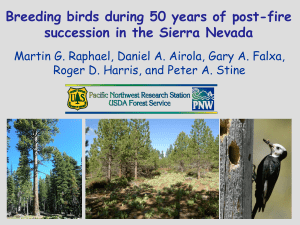

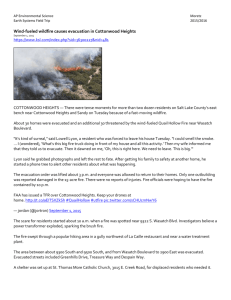
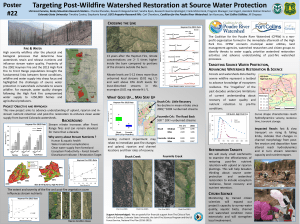
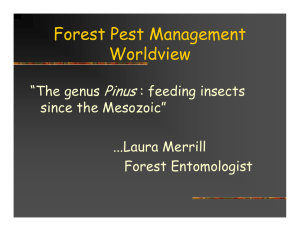
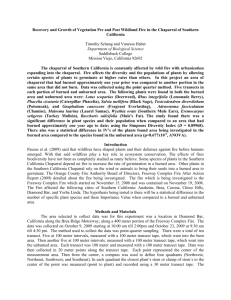

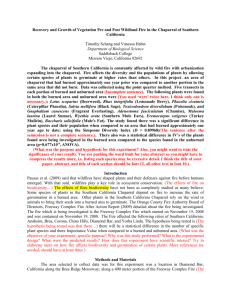
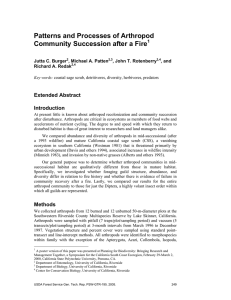
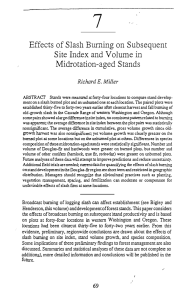
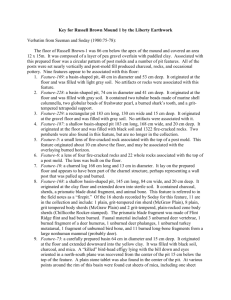
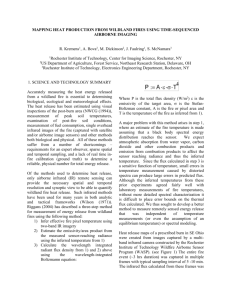
![Observations of Arthropod Populations Following the La Mesa Fire of 197']1 F.](http://s2.studylib.net/store/data/011866263_1-edbdb5f2e2ac67487d4079dde121a29f-300x300.png)
